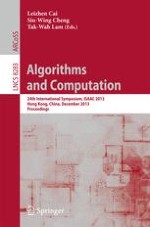This book constitutes the refereed proceedings of the 24th International Symposium on Algorithms and Computation, ISAAC 2013, held in Hong Kong, China in December 2013. The 67 revised full papers presented together with 2 invited talks were carefully reviewed and selected from 177 submissions for inclusion in the book. The focus of the volume in on the following topics: computation geometry, pattern matching, computational complexity, internet and social network algorithms, graph theory and algorithms, scheduling algorithms, fixed-parameter tractable algorithms, algorithms and data structures, algorithmic game theory, approximation algorithms and network algorithms.
